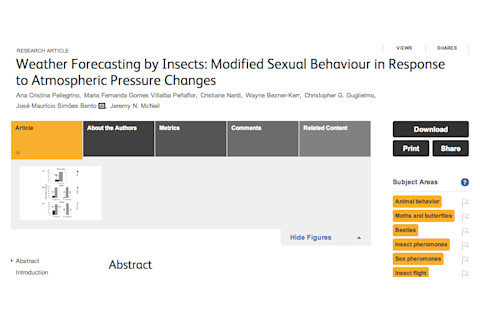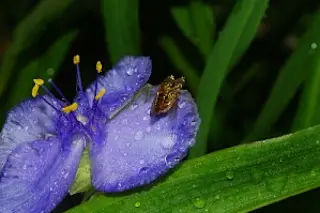Photo: flickr/DWRoseWish you could check the weather forecast more easily than looking at your iPhone or watching the Weather Channel? Yearning for more awareness of bug sex in your daily life? Then this paper is for you! The authors examined how the weather---or, more specifically, atmospheric pressure changes--affects the sexual behavior of three insect species: the curcurbit beetle, the armyworm moth, and the potato aphid. They found that any change in the atomospheric pressure caused the bugs to be less frisky, likely to protect themselves in situations involving high winds and heavy rains (not exactly a great time for bugs to do the deed). So, if you notice that the local insects are more chaste than usual, better batten down the hatches-- it means a storm's movin' in! Weather Forecasting by Insects: Modified Sexual Behaviour in Response to Atmospheric Pressure Changes "Prevailing abiotic conditions may positively or negatively impact insects at both the individual and population levels. For example while moderate rainfall and wind velocity may provide conditions that favour development, as well as movement within and between habitats, high winds and heavy rains can significantly decrease life expectancy. There is some evidence that insects adjust their behaviours associated with flight, mating and foraging in response to changes in barometric pressure. We studied changes in different mating behaviours of three taxonomically unrelated insects, the curcurbit beetle, Diabrotica speciosa (Coleoptera), the true armyworm moth, Pseudaletia unipuncta (Lepidoptera) and the potato aphid, Macrosiphum euphorbiae (Hemiptera), when subjected to natural or experimentally manipulated changes in atmospheric pressure. In response to decreasing barometric pressure, male beetles exhibited decreased locomotory activity in a Y-tube olfactometer with female pheromone extracts. However, when placed in close proximity to females, they exhibited reduced courtship sequences and the precopulatory period. Under the same situations, females of the true armyworm and the potato aphid exhibited significantly reduced calling behaviour. Neither the movement of male beetles nor the calling of armyworm females differed between stable and increasing atmospheric pressure conditions. However, in the case of the armyworm there was a significant decrease in the incidence of mating under rising atmospheric conditions, suggesting an effect on male behaviour. When atmospheric pressure rose, very few M. euphorbiae oviparae called. This was similar to the situation observed under decreasing conditions, and consequently very little mating was observed in this species except under stable conditions. All species exhibited behavioural modifications, but there were interspecific differences related to size-related flight ability and the diel periodicity of mating activity. We postulate that the observed behavioral modifications, especially under decreasing barometric pressure would reduce the probability of injury or death under adverse weather conditions."

Related content: NCBI ROFL: What does bed bug sex smell like?
NCBI ROFL: Hey baby, your snot trail really turns me on…
It’s a bird! It’s a plane! No, it’s phantom-smeller-weather-prediction-man!














